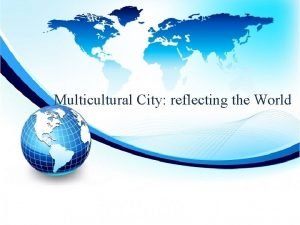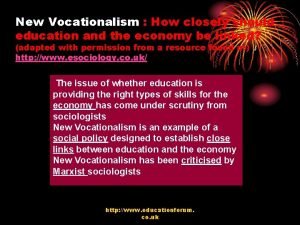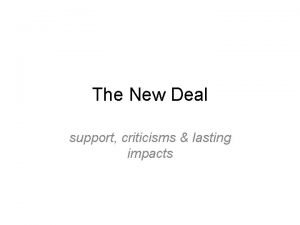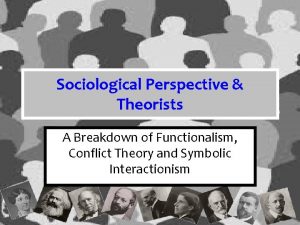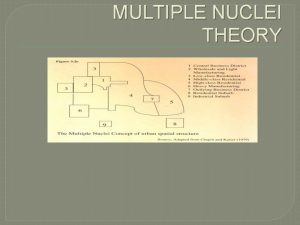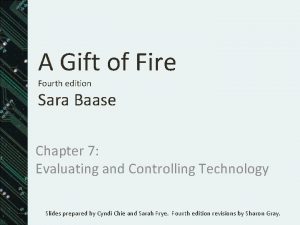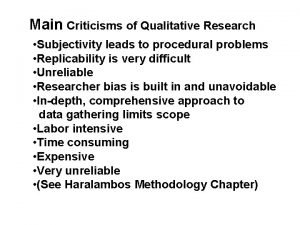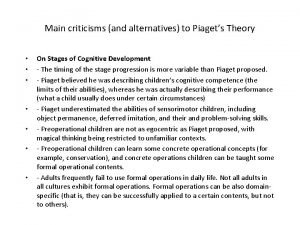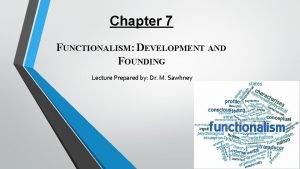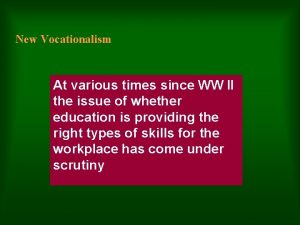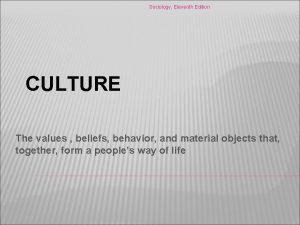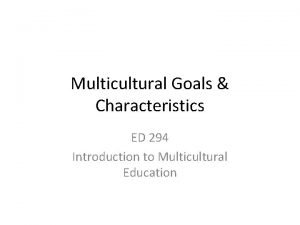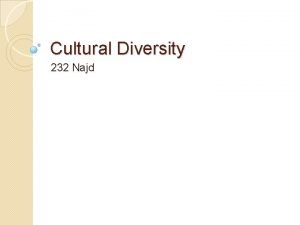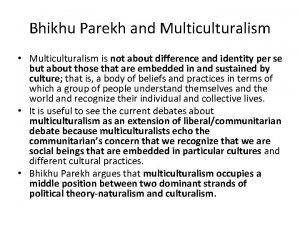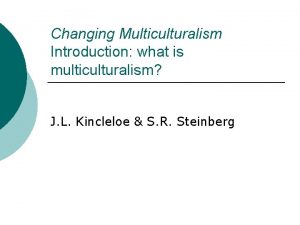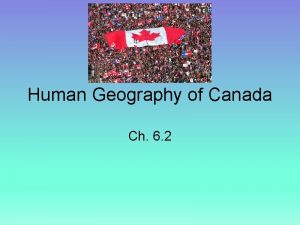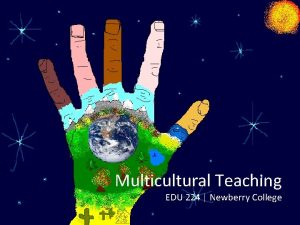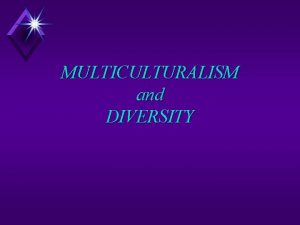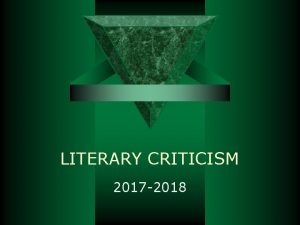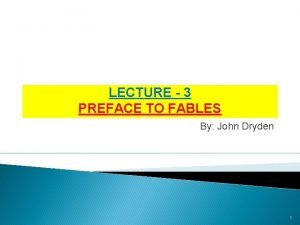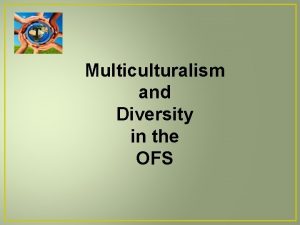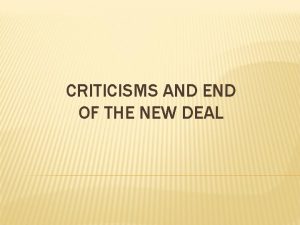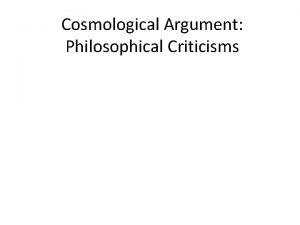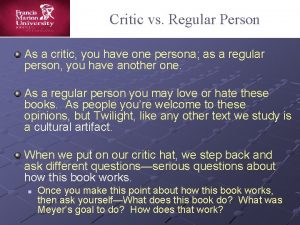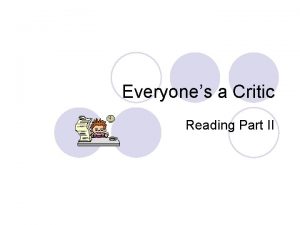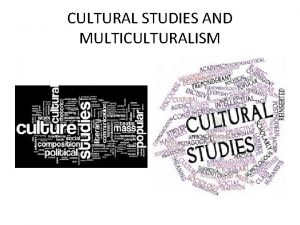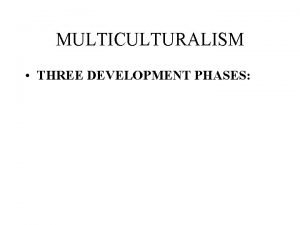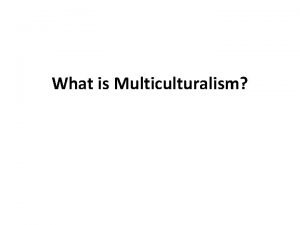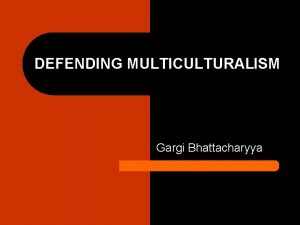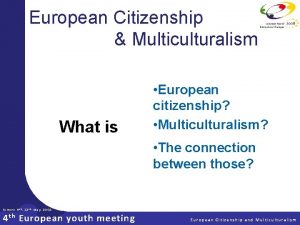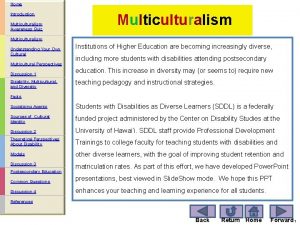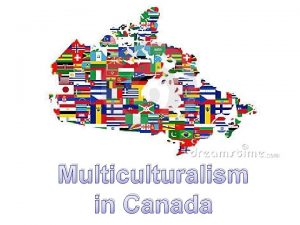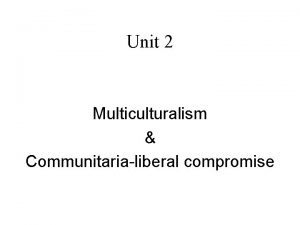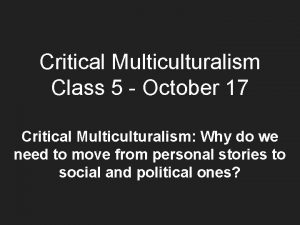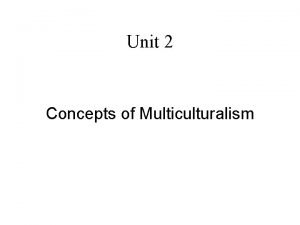Everyones a Critic Addressing Criticisms of Multiculturalism and


![Introduction • “Opponents of Multiculturalism seem to use the word [multiculturalism] to indicate their Introduction • “Opponents of Multiculturalism seem to use the word [multiculturalism] to indicate their](https://slidetodoc.com/presentation_image/092a12756f029a2da994d6e5c6a5217a/image-3.jpg)





























- Slides: 32

Everyone’s a Critic: Addressing Criticisms of Multiculturalism and Immigration in Canada Presentation by: John Biles* Director, Partnerships and Knowledge Transfer Metropolis Project Presented at: MER Colloquium University of Western Ontario January 15, 2009 *The opinions expressed in this presentation are those of the author and do not necessarily reflect 1 those of the Metropolis Project, Citizenship and Immigration Canada, or the Government of Canada.

Table of Contents • • • Introduction Multiculturalism Immigration Critics Criticisms Conclusion 2
![Introduction Opponents of Multiculturalism seem to use the word multiculturalism to indicate their Introduction • “Opponents of Multiculturalism seem to use the word [multiculturalism] to indicate their](https://slidetodoc.com/presentation_image/092a12756f029a2da994d6e5c6a5217a/image-3.jpg)
Introduction • “Opponents of Multiculturalism seem to use the word [multiculturalism] to indicate their dislike of a number of changes occurring within Canada in the last three or four decades, with the nature of their criticism going well beyond the nominal target of official multiculturalism” (Earnscliffe Research 1996] 3

Introduction (cont. ) Significant elision between Multiculturalism and Immigration for both proponents and opponents of multiculturalism Will Kymlicka Finding Our Way: Rethinking Ethnocultural Relations in Canada (1998) Diane Francis Immigration: The Economic Case (2002) Daniel Stoffman Who Gets In: What’s Wrong with Canada’s Immigration Program and How to Fix It (2002) Peter Li Destination Canada: Immigration Debates and Issues (2002) Michael Adams Unlikely Utopia: The Surprising Triumph of Canadian Pluralism (2007) This will probably accelerate now that the multiculturalism program has been moved from Canadian Heritage to Citizenship and Immigration Canada. Immigration is at least theoretically a societal choice. Multiculturalism is a demographic reality. 4

Multiculturalism Levels of Meaning of Multiculturalism AS FACT AS IDEOLOGY AS POLICY AS PRACTICE AS CRITICAL DISCOURSE Descriptive and empirical statement of what is Prescriptive and projective statement of what ought to be Explicit government initiatives to foster social equality, cultural diversity, and national interests Putting multiculturalism into practice at two levels (a) political and (b) minority women and men Challenge, resist, and transform the distribution of cultural power in society (Fleras and Kunz 2001: 7) 5

Multiculturalism as Fact • Little argument courtesy of Statistics Canada, Ethnic Diversity Survey, and Other Data Sources. • To the extent that there is criticism, it is mostly a lament for a bygone era and a longing for a fictional homogeneous, simpler past. • Canada is ethnically, religiously, linguistically and racially diverse and would continue to become ever more so even if immigration ended tomorrow. 6

Multiculturalism as Fact (cont. ) • Ethnicity / Visible Minority In 2006 16. 2% of Canadians identified as visible minorities, representing over 215 different ethnic origins Demographic projections suggest that by 2017 this will rise to 19 -23% • Religion In 2001 43% of Canadians identified as Catholic, 28% as Protestant, 2% Muslim, 1% Jewish, 1% Hindu, 1% Sikh, and 1% Buddist Demographic projections suggest non-Xian religions to increase from roughly 6% in 2001 to 10 -11% by 2017. • Language In 2006 anglophones represented 57. 8% of the population, francophones 22. 1% and allophones 20. 1% 7

Multiculturalism as Ideology • Has come to be accepted as a public idea in Canada – Canadian identity is often said to include bilingualism and multiculturalism. • Critics occasionally cite opinion polls with numbers that show lower numbers, but the preponderance of polls are overwhelmingly supportive of the idea. • Both proponents and opponents are entrenched in their beliefs. 8

Multiculturalism as Policy • Federal, provincial, municipal, and institutional policies are in place (Garcea 2006). • Multiculturalism versus Interculturalism is a recurrent theme in the literature (Labelle 2009). • Some critics argue that the policy is misleading as we have not achieved the full participation of all Canadians in the social, cultural, economic and political realms of Canadian society (Li 2002). • Others argue that multiculturalism is okay, provided it remains in the private realm. Government should NOT provide legitimacy or funding to support it. 9

Multiculturalism as Practice • Reasonable accommodation long pre-dates Bouchard. Taylor in Quebec. • It plays out on the ground across the country on a daily basis. • Treating neighbours, friends, classmates, and strangers with dignity and respect is a very “Canadian” thing to do. • Critics seize upon the exceptions to the rule to generate media coverage and outrage. 10

Multiculturalism as Critical Discourse • Power – Who is at the tables where decisions are made? – My diversity is okay, but yours isn’t • Privilege – Division between “your church” and “our” state • Equity – Substantive versus formal equality • Change – So what? – Who is in a position to effect change? – No one surrenders power and privilege willingly 11

Common Critiques of Immigration • Xenophobia – Health (TBS, HIV, SARS, Leprosy) – Safety (Crime, Violence and Terrorism) • Economic Impact • Machinery of Immigration – Corruption & Malfeasance – Confusion among immigrant “classes” – Difficulties of entry and exit • Social Cohesion / Integration 12

Critics • Critics publish in many venues, including popular publications, the media, and academic literature. • Critics comes from all along the political spectrum. • Critics, like many proponents of multiculturalism, do not let empirical evidence stand in the way of a heart felt ideological position. • In a pinch international examples can make 2+2=5 • Isolated examples can be generalized to great effect (e. g. “honour killings” and other crimes). 13

Critics • While the critics are ubiquitous, some garner more headlines than others. Those infamous for their views include: – James Bissett “Security Threats in Immigration and Refugee Policy” (2007) – Neil Bissoondath Selling Illusions: The Cult of Multiculturalism in Canada (1994) – Martin Collacott “Canada’s Immigration Policy: The Need for Major Reform” (2002) – Allan Gregg “Identity Crisis” (The Walrus March 2006) 14

Criticisms (cont. ) • There have been various efforts to summarize and debunk criticisms: – Will Kymlicka (1998) • Undermines integration; obligation to accept illiberal practices – John Biles (2002) • Divisive nature; political expediency; threat to the status quo; and cultural relativism – David Ley (2007) • Fragmentation; essentialism; co-opted and commodified; exercise in false consciousness – Joe Garcea (2009) • Fragmentation/segregation; divided loyalties; hinders to development of a Canada; frustrates the aspirations of “national minorities”; imports conflict; creates conflict among minorities / fosters competition and inequality among minorities; co-ops efforts of minorities 15

Criticism (cont. ) • Generally criticisms can be loosely divided into three groupings: 1) Multiculturalism has gone too far 2) Multiculturalism hasn’t gone far enough 3) Pro-forma criticisms 16

Multiculturalism Has Gone Too Far • The Canada we knew is gone • Canada will never gel as a nation • Existential threat to Canada 17

The Canada We Knew Is Gone • Assumes a fictional homogenous and harmonious past that immigration-fuelled diversity has destroyed (Granatstein 1998, Loney 1998, Stoffman 2002) • Asserts that changes have been wrought surreptitiously without public debate (Bissoondath 1994) 18

Canada Will Never Gel as a Nation Too much focus on what divides us rather than what brings us together “The time of the “two solitudes” that for too long described the character of this country is past. The narrow notion of “every person for himself” does not belong in today’s world, which demands that we learn to see beyond our wounds, beyond our differences for the good of all. Quite the contrary: we must eliminate the spectre of all the solitudes and promote solidarity among all the citizens who make up the Canada of today. ” Governor General Michaëlle Jean’s Inauguration Speech (27 September 2005) 19

Existential Threat to Canada • Fragmentation • Terrorism and Violence • Sacrificing Liberal Democratic Values 20

Existential Threat: Fragmentation • Ethnic Enclaves “And today many of those communities are so robust that there may be a temptation amongst some new Canadians to stay within their familiar social and cultural networks, rather than venturing out into our broader society” (Kenny 2008) “. . . it is clear that the degree of ghettoization in Canada is routinely overstated within the media and, to a degree, scholarly and policy debates as well” (Hiebert, Schuurman, and Smith 2007). 21

Existential Threat: Terrorism and Violence • Imported conflict • Crime rates • Terrorism / Radicalization 22

Existential Threat: Values • No limits to diversity? • Gender equality Susan Okin Is Multiculturalism Bad For Women? (1999) • Division between church and state 23

Multiculturalism Hasn’t Gone Far Enough • Song and Dance (and Food/Foodways) • Essentializing Identities • Integration/Inclusion has failed 24

Song and Dance (Food and Foodways) • Culture Disneyfied / Comodified (Bissoondath 1994; Abu-Laban and Gabriel 2002) • Diminishes the power of arts and culture to effect change – e. g. Joy Kogawa’s Obasan • Importance of food and foodways / culture as economic sectors 25

Essentializing Identities • Feeds into stereotypes • Game of divide and conquer • Erases internal heterogeneity • Strategic essentialism of “visible minority” category • Recent U. N. controversy 26

Integration/Inclusion has Failed • Using Kymlicka’s metrics Canada has: a) High naturalization rates b) High rates of intermarriage c) High rates of acquisition of official languages • Even the cases that dominate public discourse follow the rules – sharia tribunals in Ontario; Mark Steyn’s article in Maclean’s and subsequent Human Rights Commission Cases • Our record is mixed on integration outcomes in the social, cultural, civic and economic spheres • Increasing interest in outcomes for second generation Canadians 27

Pro-forma Criticisms • Waste of Money • Crass Politics • Reverse Discrimination 28

Waste of Money • “Multiculturalism has, over the years, acquired aspects of a holy cow for many, a cash cow for some. ” (Bissoondath 1994: 6). • Next fiscal year funds expended by the Multiculturalism Program through its grants and contributions program will be $11. 4 million 29

Crass Politics “Immigration and multiculturalism are life rafts on the Liberal ship” (Stoffman 2002: 128). “The federal Liberals are so dependent upon the votes of multicultural Canadians. . . That they aren’t very likely to undertake a serious review of official multiculturalism (Gwyn 1995: 202). “The Conservatives under Brian Mulroney also saw the electoral advantages to be gained by promoting links with ethnic groups and promoting multiculturalism policies” (Loney 1999: 148). “Mission: Immigration. Tories hope for a breakthrough with visible minorities” (National Post 11 September 2008: A 5). 30

Reverse Discrimination “Pale patriarchal penis people” (Gwyn 1995: 157) Martin Loney The Pursuit of Division: Race, Gender and Preferential Hiring in Canada (1998) Impact of Rae government in Ontario’s advertisements indicating that “white males need not apply” – end of employment equity in Ontario under Mike Harris 31

Conclusion • Most criticisms have long histories and manifest themselves in various guises depending upon present day circumstances; • Accordingly, there is no excuse for lacking an empirical evidence base to examine these critiques, and yet. . . 32
 Everyones doing it
Everyones doing it Flat addressing vs hierarchical addressing
Flat addressing vs hierarchical addressing Multiculturalism pros and cons
Multiculturalism pros and cons Inner defender examples
Inner defender examples By listening to my inner defender voice i can be sure that
By listening to my inner defender voice i can be sure that Criticisms of vocational education sociology
Criticisms of vocational education sociology Myth of parentocracy
Myth of parentocracy New deal criticisms
New deal criticisms Symbolic interactionist perspective
Symbolic interactionist perspective Criticisms of the sick role
Criticisms of the sick role Supplier power.
Supplier power. Summary of natural law
Summary of natural law Multiple nuclei model.
Multiple nuclei model. Neo luddite criticisms of computer technology
Neo luddite criticisms of computer technology Criticisms of qualitative research
Criticisms of qualitative research Criticisms of piagets theory
Criticisms of piagets theory Functionalism founder
Functionalism founder Criticisms of vocational education
Criticisms of vocational education Multiculturalism sociology
Multiculturalism sociology Definition of multiculturalism
Definition of multiculturalism Examples of multiculturalism
Examples of multiculturalism Example of subculture
Example of subculture Bhikhu parekh multiculturalism upsc
Bhikhu parekh multiculturalism upsc Stepek ap human geo
Stepek ap human geo Changing multiculturalism
Changing multiculturalism Monument to multiculturalism
Monument to multiculturalism Multiculturalism ap human geography
Multiculturalism ap human geography Paul ilsley
Paul ilsley Multiculturalism definition
Multiculturalism definition Multiculturalism
Multiculturalism Horace
Horace Structuralism and formalism
Structuralism and formalism Chaucer as a father of english poetry slideshare
Chaucer as a father of english poetry slideshare


